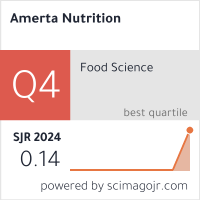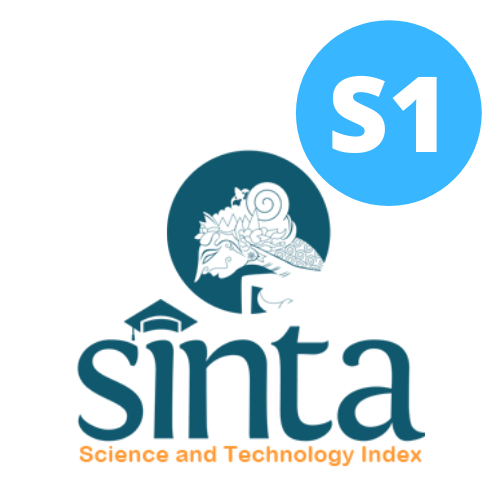The Relationship Between Chrononutrition with Nutritional Status, Mid Upper Arm Circumference and Anemia in Adolescent Girl
Hubungan Chrononutrition Terhadap Status Gizi, Lingkar Lengan Atas, dan Anemia pada Remaja Putri
Background: The Adolescents are currently facing the triple burden, which includes undernutrition, overnutrition or obesity, and micronutrient deficiencies. The nutritional status of adolescents was influenced by chrononutrition. Chrononutrition has a significant relationship with nutritional status. However, there are no studies in Indonesia that specifically examine the relationship between chrononutrition and nutritional status, Mid Upper Arm Circumference (MUAC), and anemia in adolescent girls.
Objectives: This study aimed to analyze the relationship between chrononutrition and nutritional status in adolescents.
Methods: This study was cross-sectional, that was conducted in Senior High School in Widodaren, Ngawi, in August until september 2024. The population in this study were teenager aged 14-19 years with a sampel size of 100 respondents calculated using the Lemeshow formula. The independent variable was chrononutrition namely breakfast skipping, evening eating and night eating. The chrononutrition was obtained using Chrononutrition Profile Questionnaire. Meanwhile the dependent variable was nutritional status using Body Mass Index/Age, anemia level using hemoglobin and chronic energy deficiency level which was obtained by mid upper arm circumference. The data was analyzed by chi square and fisher.
Results: There was a relationship between chrononutrition namely breakfast skip (p-value=0.046), night eating (p-value=0.016), and evening eating (p-value=0.01) with nutritional status. There was relationship between chrononutrition namely breakfast skipping (p-value=0.003), night eating (p-value=0.001) and evening eating (p-value=0.03) with Anemia in Adolescent Girl. There was no relationship between chrononutrition namely breakfast skipping, and evening eating with MUAC in Adolescent girl, but there was relationship between night eating with MUAC.
Conclusions: There was relationship between chrononutrition, namely breakfast skipping, night eating and evening eating with nutritional status and anemia. There was relationship between night eating with chronic energy deficiency. Meanwhile there was no relationship between chrononutrition, namely breakfast skipping and evening eating with chronic energy deficency.
Moin, Z. L. A. & Bhutta, Z. Nutrition in Middle Childhood and Adolescence. in Child and Adolescent Health and Development. 3rd edition. Int. Bank Reconstr. Dev. (2017).
UNICEF. Strategi Komunikasi Perubahan Sosial dan Perilaku : Meningkatkan Gizi Remaja di Indonesia. (Unicef, 2021).
Kemenkes BKPK. Survei Kesehatan Indonesia Tahun 2023. Kemenkes RI (2023).
Dinkes Jatim. Profil Kesehatan Provinsi Jawa Timur 2019. (2019).
Luque, R. M. et al. An Approach to Early Detection of Metabolic Syndrome through Non-Invasive Methods in Obese Children. Children 7, 1–12 (2020). https://doi.org/; doi:10.3390/children7120304.
Raymond, J. & Morrow, K. Krause and Mahan’s Food and The Nutrition Care Process 16 The Edition. (Elsevier, 2023).
Abera, M. et al. Social , economic and cultural influences on adolescent nutrition and physical activity in Jimma , Ethiopia : perspectives from adolescents and their caregivers. Public Health Nutr. 24, 5218–5226 (2020). https://doi.org/10.1017/S1368980020001664.
Franzago, M., Alessandrelli, E., Notarangelo, S., Stuppia, L. & Vitacolonna, E. Chrono-Nutrition: Circadian Rhythm and Personalized Nutrition. Int. J. Mol. Sci. 24, (2023). https://doi.org/10.3390/ijms24032571.
Raji, O. E., Kyeremah, E. B., Sears, D. D. & Makarem, N. Chrononutrition and Cardiometabolic Health : An Overview of Epidemiological Evidence and Key Future Research Directions. Nutrients 16, (2024). https://doi.org/https://doi.org/10.3390/nu16142332.
Drăgoi, C. M., Nicolae, A. C., Grădinaru, D. & Dumitrescu, I.-B. Circadian Rhythms, Chrononutrition, Physical Training, and Redox Homeostasis—Molecular Mechanisms in Human Health. Celss 13, (2024). https://doi.org/https://doi.org/10.3390/cells13020138.
Veronda, A. C. & Irish, L. A. Evaluation of the Chrononutrition Profile – Questionnaire in an online community sample of adults. Eat. Behav. 45, (2022). https://doi.org/10.1016/j.eatbeh.2022.101633.
Borisenkov, M. F. et al. Association of Chrononutrition Indices with Anthropometric Parameters , Academic Performance , and Psychoemotional State of Adolescents : A Cross-Sectional Study. Nutrients 15, (2023). https://doi.org/https://doi.org/10.3390/nu15214521.
Vilela, S., Oliveira, A., Severo, M. & Lopes, C. Chrono-Nutrition : The Relationship between Time-of- Day Energy and Macronutrient Intake and Children ’ s Body Weight Status. J. Biol. Thytmhs 33, 332–342 (2019). https://doi.org/10.1177/0748730419838908.
Veronda, A. C., Kline, C. E. & Irish, L. A. The impact of circadian timing on energy balance: an extension of the energy balance model. Health Psychol. Rev. 16, 161–203 (2022). https://doi.org/10.1080/17437199.2021.1968310.
Mentzelou, M. et al. Chrononutrition in the Prevention and Management of Metabolic Disorders: A Literature Review. Nutrients 16, (2024). https://doi.org/10.3390/nu16050722.
Istiharini, B., Sulaiman, L. & Sismulyanto. Hubungan antara frekuensi makan, kebiasaan sarapan dan anemia dengan kejadian kurang energi kronis pada remaja putri. J. Kesehat. Qamarul Huda 12, 59–66 (2024). https://doi.org/10.37824/jkqh.v12i2.2024.688.
Sayed, S. F. & Nagarajan, S. Haemoglobin status to determine nutritional anaemia and its association with breakfast skipping and BMI among nursing undergraduates of Farasan Island, KSA. J. Nutr. Sci. 11, 1–10 (2022). https://doi.org/10.1017/jns.2022.33.
Andiarna, F. Analysis of Breakfast Habits on The Incidence of Anemia International Conference on Sustainable Health Promotion 2018 Analysis of Breakfast Habits on The Incidence of Anemia. Int. Conf. Sustain. Heal. Promot. 2018 (2020).
Utomo, R., Nicky, T., Setianingrum, E. L. S., Kareri, D. G. R. & Lada, C. O. The Relationship between Sleep Quality with Hemoglobin Levels and Erythrocyte Index of Medical Students at Universitas Nusa Cendana. East African Sch. J. Med. Sci. 4421, 40–48 (2023). https://doi.org/10.36349/easms.2023.v06i02.003.
Ariani, N. L., Sudiwati, N. L. P. E., Panggayuh, A. & Khofifah, K. Pengaruh Kualitas Tidur terhadap Kadar Hemoglobin Calon Pendonor di UTD Kabupaten Sidoarjo. Care J. Ilm. Ilmu Kesehat. 10, 139–147 (2022).https://doi.org/10.33366/jc.v10i1.3214.
Indi Antika Falentina, Eva Silviana Rahmawati & Lilia Faridatul Fauziah. Hubungan Asupan Zat Gizi Makro dengan Status Gizi Berdasarkan LILA pada Remaja Putri di SMA Negeri 2 dan 4 Kecamatan Tuban. INSOLOGI J. Sains dan Teknol. 2, 1155–1165 (2023). https://doi.org/10.55123/insologi.v2i6.2972.
Alfiah, S. & Dainy, N. C. Asupan Zat Besi, Vitamin C dan Konsumsi Tablet Tambah Darah Berhubungan dengan Kejadian Anemia Remaja Putri SMPIT Majmaul Bahrain Bogor. J. Ilmu Gizi dan Diet. 2, 103–108 (2023). https://doi.org/10.25182/jigd.2023.2.2.103-108.
Sopiyudin, D. Besar Sampel dalam Penelitian Kedokteran dan Kesehatan. (Epidemiologi Indonesia, 2016).
Karim, M. A. Hubungan asupan makanan, Aktivitas fisik dengan status gizi peserta didik kelas VII SMP Negeri 5 Sleman. Univ. Negeri Yogyakarta 6–18 (2017).
Hairudin, K. F., Mohd Fahmi Teng, N. I. & Juliana, N. Adaptation and Validation of the Malay-Chrononutrition Profile Questionnaire to Assess Chrononutrition Behavior of Young Adults in Malaysia. Curr. Dev. Nutr. 7, 100009 (2023). https://doi.org/10.1016/j.cdnut.2022.100009
Kementerian Kesehatan RI. Peraturan Menteri Kesehatan Republik Indonesia Nomor 2 Tahun 2020 Tentang Standar Antropometri Anak. (2020).
WHO. Guideline on haemoglobin cutoffs to define anaemia in individuals and populations. Sustainability (Switzerland) vol. 11 (World Health Organization, 2024).
Gibson, R. Principle of Nutritional Assessment. United States of Oxford, Amerika (2005).
Dahlan, S. Statistik Untuk Kedokteran dan Kesehatan. (Salemba Medika, 2015).
Khusun, H. et al. Breakfast Consumption and Quality of Macro- and Micronutrient Intake in Indonesia: A Study from the Indonesian Food Barometer. Nutrients 15, 1–16 (2023). https://doi.org/10.3390/nu15173792.
Ricotti, R. et al. Breakfast Skipping, Weight, Cardiometabolic Risk, and Nutrition Quality in Children and Adolescents: A Systematic Review of Randomized Controlled and Intervention Longitudinal Trials Roberta. Nutrients 13, (2021). https://doi.org/https://doi.org/10.3390/nu16142332.
Haldar, P., James, A. & Negi, U. Breakfast Eating Habits and Its In fl uence on Nutritional Status. J. Heal. Allied Sci. 0–3 (2023) doi:https://doi.org/ 10.1055/s-0043-1777021.
Olatona, F. A. & Oloruntola, O. O. Association Between Breakfast Consumption and Anthropometrically Determined Nutritional Status of Secondary-School Adolescents in Lagos , Southwest Nigeria. Int. J. Matern. Child Heal. AIDS 11, (2022). https://doi.org/10.21106/ijma.503.
Yoshida, J., Eguchi, E., Nagaoka, K., Ito, T. & Ogino, K. Association of night eating habits with metabolic syndrome and its components : a longitudinal study. BMC Pediatr. 18, 1–12 (2018).https://doi.org/10.1186/s12889-018-6262-3.
Putri, S. A., Marjan, A. Q., Sofianita, N. I. & Simanungkalit, S. F. Night Eating Syndrome, Fiber Intake, and Household Income with Occurrence of Overnutrition among SMAN 6 Depok Students. Amerta Nutr. 7, 132–138 (2023).https://doi.org/1 0.20473/amnt.v7i2SP.2023.13 2-138.
Agofure, O., Odjimogho, S., Okandeji-Barry, O. & Moses, V. Dietary pattern and nutritional status of female adolescents in amai secondary school, delta state, Nigeria. Pan Afr. Med. J. 38, 1–10 (2021). https://doi.org/10.11604/pamj.2021.38.32.15824.
Abubakar, H. A., Shahril, M. R. & Mat, S. Nutritional status and dietary intake among Nigerian adolescent: a systematic review. BMC Public Health 24, 1–13 (2024). https://doi.org/10.1186/s12889-024-19219-w.
Setiawan, A. S., Budiarto, A. & Indriyanti, R. Eating behavior of adolescent girls in countries with a high prevalence of stunting under five: a systematic review. Front. Psychol. 14, (2023). https://doi.org/10.3389/fpsyg.2023.1228413.
Haryana, N. R., Rosmiati, R., Purba, E. M. & Firmansyah, H. Gaya Hidup Generasi Z Dalam Konteks Perilaku Makan, Tingkat Stres, Kualitas Tidur dan Kaitannya Dengan Status Gizi: Literature Review. J. Gizi Kerja dan Produkt. 4, 253–268 (2023). https://doi.org/10.52742/jgkp.v4i2.195.
Firmanurochim, W., Romadhon, A., Nurhidayati, I. N., Dasuki, M. & Shoim, M. Hubungan Kebiasaan Makan Malam dan Tingkat Stres dengan Kejadian Obesitas pada Remaja Putri. Univ. Muhammadiyah Surakarta 290–298 (2021).
Lopez-Minguez, J., Gómez-Abellán, P. & Garaulet, M. Timing of breakfast, lunch, and dinner. Effects on obesity and metabolic risk. Nutrients 11, 1–15 (2019). https://doi.org/10.3390/nu11112624.
Kinsey, A. W. & Ormsbee, M. J. The Health Impact of Nighttime Eating: Old and New Perspectives. Nutrients 7, 2648–2662 (2015). https://doi.org/10.3390/nu7042648.
Madjd, A. et al. Effects of consuming later evening meal v . earlier evening meal on weight loss during a weight loss diet : a randomised clinical trial. Br. J. Nutr. 126, 632–640 (2021). https://doi.org/10.1017/S0007114520004456.
Xiao, Q., Garaulet, M. & Scheer, F. Meal timing and obesity; interactions with macronutrient intake and chronotype Qian. HHS Public Acces 43, 1701–1711 (2019). https://doi.org/10.1038/s41366-018-0284-x.Meal.
Okada, C., Imano, H., Muraki, I., Yamada, K. & Iso, H. The Association of Having a Late Dinner or Bedtime Snack and Skipping Breakfast with Overweight in Japanese Women. J. Obes. 2019, (2019). https://doi.org/10.1155/2019/2439571.
Barracosa, R. & Silva, C. The impact of meal timing on body composition: The role of Chrononutrition. REVISÃO TEMÁTICA (2021).
Halawa, D. A. P. T., Sudargo, T. & Siswati, T. Makan Pagi, Aktivitas Fisik, dan Makan malam Berhubungan dengan Status Gizi Remaja di Kota Yogyakarta. J. Nutr. Coll. 11, 135–142 (2022). https://doi.org/10.14710/jnc.v11i2.33184.
Maryani, D., Iqbal, M., Suryana, A. L., Widyawati, A. & Jannah, M. Hubungan Sindrom Makan Malam dengan Obesitas pada Mahasiswa di Politeknik Negeri Jember. HARENA J. Gizi 4, (2018). https://doi.org/10.25047/harena.v4i1.4619.
Pibriyanti, K., Zahro, L., Ummah, S. K., Luthfiya, L. & Sari, F. K. Macronutrient, nutritional status, and anemia incidence in adolescents at Islamic boarding school. J. Gizi Klin. Indones. 18, 97 (2021). https://doi.org/10.22146/ijcn.63122.
Pibriyanti, K. & Zahro, L. Relationship between micronutrient and anemia incidence in adolencents at Islamic boarding school. Hafidhotun Nabawiyah 8, 130–135 (2020). http://dx.doi.org/10.21927/ijnd.2020.8.
Hartini, S., Prihandono, D. S. & Gustiani, D. Analisis Kadar Hemoglobin Mahasiswa dengan Kebiasaan Sarapan. J. Heal. Sci. Gorontalo J. Heal. Sci. Community 8, 43–51 (2024). https://doi.org/10.35971/gojhes.v8i1.21929.
Basuki, J. Hubungan Kebiasaan Sarapan dan Aktivitas Fisik dengan Kadar Hemoglobin Remaja Putri Di SMK Muhammadiyah 2 Karanganyar. (Institut Teknologi Sains dan Kesehatan, PKU Muhammadiyah Surakarta, 2019).
Merlisia M, Setyarsih L, Novianti TA, Arnisaputri D, C. J. Hubungan Kebiasaan Sarapan Pagi dengan Kejadian Anemia pada Remaja Putri di Wilayah Kerja Puskesmas Rawasari Kota Jambi. Nightingale J Nurs 12, 9–12 (2024).
Laili, A. N., Rahmawati, L. & Laowo, A. Relationship between Breakfast Habits and the Incidence of Anemia in Adolescents. ASSYIFA J. Ilmu Kesehat. 1, 43–47 (2023).httpsL//doi.org/10.62085/ajk.v1i1.7.
Istawati, R. Jurnal Endurance : Kajian Ilmiah Problema Kesehatan Analisis Faktor-Faktor yang Berhubungan Dengan Kejadian Anemia pada Remaja Puteri. J. Endur. Kaji. Ilm. Probl. Kesehat. 7, 48–57 (2022). http://doi.org/10.22216/endurance.v7i1.774.
Arisnawati, A. & Zakiudin, A. Hubungan Kebiasaan Makan Pagi Dengan Kejadian Anemia Pada Remaja Putri Di Sma Al Hikmah 2 Benda Sirampog Brebes. Para pemikir J. Ilm. Farm. 7, 233–238 (2018). https://doi.org/10.30591/pjif.v7i1.752.
Chen, Z., Cao, B., Liu, L., Tang, X. & Xu, H. Association between obesity and anemia in an nationally representative sample of United States adults: a cross-sectional study. Front. Nutr. 11, (2024). https://doi.org/10.3389/fnut.2024.1304127.
Ahmed, M., Kashoo, F., Alqahtani, M. & Sami, W. Relation Between Night Eating Syndrome and Academic Grades Among University Students Original Article Relation Between Night Eating Syndrome and Academic Grades Among University Students Üniversite Öğrencilerinde Gece Yeme Sendromu ve Akademik Derece Aras. Turk J Endocinol Metab (2019) https://doi.orh10.25179/tjem.2018-63015.
Maw, S. S. & Haga, C. Effect of a 2-hour interval between dinner and bedtime on glycated haemoglobin levels in middle-aged and elderly Japanese people : a longitudinal analysis of 3-year health check-up data. BMJ Nutr. Prev. Heal. 1–10 (2019) doi:10.5061/dryad.kg183m5.
Sarjono, L., Pandelaki, K. & Ongkowijaya, J. Perbedaan kadar hemoglobin pada mahasiswa Fakultas Kedokteran Universitas Sam Ratulangi berdasarkan kualitas tidur Kandidat Skripsi Fakultas Kedokteran Universitas Sam Ratulangi Manado Tidur didefinisikan sebagai suatu keadaan bawah sadar saat orang terse. J. e-Clinic 4, 5–8 (2016).
Abrianti, F. ambaran kadar hemoglobin penjual makanan pada malam hari di wilayah anduonohu kec. poasia kota kendari provinsi sulawesi tenggara. (Politeknik Kesehatan Kendari, 2016).
Yogie, Lestari, R. M. & Baringbing, E. P. Hubungan Kebiasaan Pola Tidur dengan Kejadian Anemia pada Remaja di Puskesmas Pahandut Kota Palangka Raya The Correlation of Habitual Sleep Pattern with the Incidence Anemia in Teenagers at the Pahandut Health Center in Palangka Raya. J. Surya Med. 2, (2024).
Pibriyanti, K. et al. Hubungan Pengetahuan, Sikap, Tindakan, Durasi Tidur Dengan Kejadian Anemia Pada Remaja Putri di Pondok Pesantren. J. Kesehat. Glob. 6, 18–26 (2023).https://doi.org/ 10.33085/jkg.v6i1.5523.
Bebasari, E., Putri, A., Khaerina, R. & Destiani, F. Hubungan Frekuensi Makan dan Pola Tidur dengan Kejadian Anemia pada Remaja Putri di SMP Negeri 2 Labuapi Tahun 2024. J. Ganec Swara 18, 2431–2435 (2024).https://doi.org/ 10.35327/gara.v18i4.1192.
Trabzon, M. et al. Nighttime feeding in Turkish children and its association with anemia. Open J. Pediatr. 02, 67–72 (2012). https://doi.org/10.4236/ojped.2012.21011.
Matsumoto, M., Hatamoto, Y., Sakamoto, A., Masumoto, A. & Ikemoto, S. Breakfast skipping is related to inadequacy of vitamin and mineral intakes among Japanese female junior high school students: A cross-sectional study. J. Nutr. Sci. 9, (2020). https://doi.org/10.1017/jns.2019.44.
Thorup, L. et al. Mid-upper arm circumference as an indicator of underweight in adults: a cross-sectional study from Nepal. BMC Public Health 20, 1–7 (2020). https://doi.org/10.1186/s12889-020-09294-0.
Sisay, B. G., Hassen, H. Y., Jima, B. R., Atlantis, E. & Gebreyesus, S. H. The performance of mid-upper arm circumference for identifying children and adolescents with overweight and obesity: A systematic review and meta-Analysis. Public Health Nutr. 25, 607–616 (2022). https://doi.org/10.1017/S1368980022000143.
Sari, B. P., Khairani, M. D., Abdullah & Muharramah, A. Hubungan Tingkat Pengetahuan Gizi Dan Body Image Dengan Kurang Energi Kronik Remaja Putri Di SMAN 2 Pringsewu. Innov. J. Soc. Sci. Res. 4, 6700–6708 (2024).
Tan, C. C. & Ibrahim. Hubungan Body Image dengan Pola Makan Pada Remaja Putri. Zo. Kebidanan 11, 40–45 (2020). https://doi.org/10.37776/zkeb.v11i1.695.
Dewi, A. P., Abdullah & Pratiwi, A. R. Hubungan Asupan Gizi dan Pengetahuan Gizi dengan LILA (Lingkar Lengan Atas) Remaja Putri di Pekon Pamenang. J. Gizi Aisyah 6, (2023).https://doi.org/ 10.30604/jnf.v6i1.809.
Putri, M. C. et al. Hubungan Asupan Makan dengan Kejadian Kurang Energi Kronis ( KEK ) pada Wanita Usia Subur ( WUS ) di Kecamatan Terbanggi Besar Kabupaten Lampung Tengah. J Agromedicine 6, 105–113 (2019). https://doi.org/10.20473/amnt.v7i2SP.2023.132-138.
Musa, I. R., Omar, S. M., Aleed, A., Al-Nafeesah, A. & Adam, I. Mid-upper arm circumference as a screening tool for identifying underweight adolescents. Front. Nutr. 1–6 (2023) https://doi.org/10.3389/fnut.2023.1200077.
Copyright (c) 2025 Amerta Nutrition

This work is licensed under a Creative Commons Attribution-ShareAlike 4.0 International License.
AMERTA NUTR by Unair is licensed under a Creative Commons Attribution-ShareAlike 4.0 International License.
1. The journal allows the author to hold the copyright of the article without restrictions.
2. The journal allows the author(s) to retain publishing rights without restrictions
3. The legal formal aspect of journal publication accessibility refers to Creative Commons Attribution Share-Alike (CC BY-SA).
4. The Creative Commons Attribution Share-Alike (CC BY-SA) license allows re-distribution and re-use of a licensed work on the conditions that the creator is appropriately credited and that any derivative work is made available under "the same, similar or a compatible license”. Other than the conditions mentioned above, the editorial board is not responsible for copyright violation.












































